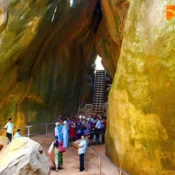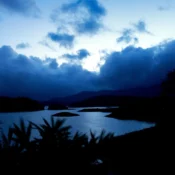
8 Beautiful Forts and Palaces in Udaipur for a Royal Retreat
When thinking about Rajasthan, the first thing that comes to mind is the strong fort and luxurious palace in Udaipur. Synonymous with striking architecture, elaborate design and grand all-around vibe, these grand palaces of Udaipur enchant the grandeur and grandeur in all their forms. Establishing the true nature of Rajputana and resonating with Mewar culture, some of these palaces were summer resorts, some were pleasure residences and others were built just to present the world with the magic of royalty. Featuring several monuments of historical importance, the grand city of Udaipur is ideal for romantic getaways, family holidays or just a getaway with friends.
Here is the list of 8 Beautiful Palaces in Udaipur for a Royal Retreat
1. City Palace, Udaipur
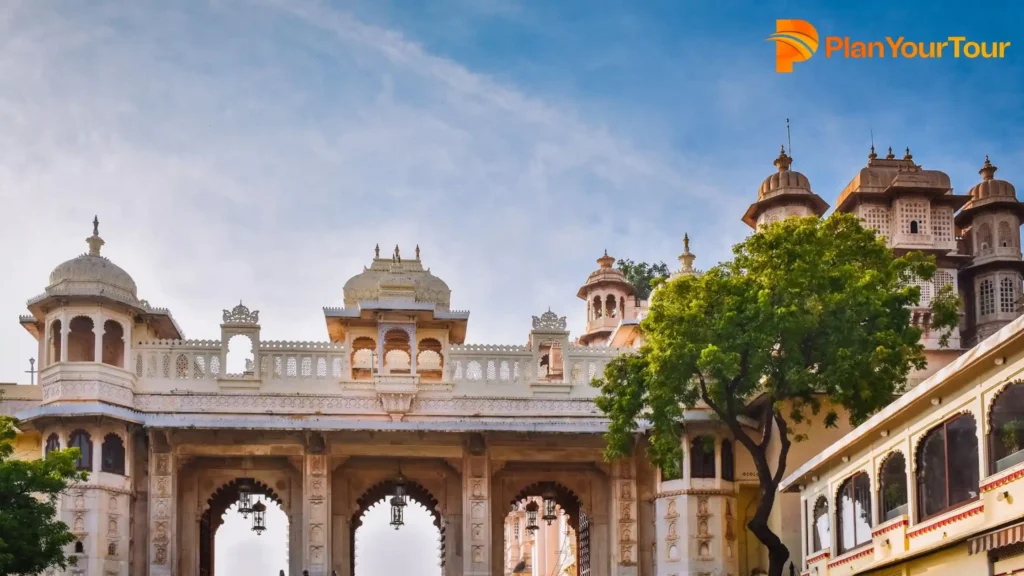
The City Palace of Udaipur, built on the banks of Lake Pichola, is considered to be the largest royal complex in Rajasthan. The magnificent palace was built by Maharana Udai Singh in the year 1559 and served as the main seat of power, from where the Maharana lived and governed the kingdom. Subsequently, the palace was made even more magnificent by his successors, who added several structures to it. The palace now has an assortment of palaces, courtyards, pavilions, corridors, terraces, rooms and hanging gardens. There is also a museum that displays some of the finest elements of Rajput art and culture – from colourful paintings to the typical architecture found in Rajasthani palaces.
Nestled in the lap of Aravalli, the granite and marble building of the City Palace stands in stark contrast to its quaint natural surroundings. The intricate architecture of the royal palace is a subtle blend of medieval, European as well as Chinese influences and is embellished with numerous domes, arches and towers. The City Palace itself is situated on a lush green garden bed and is quite attractive to watch. The royal beauty of this attraction has a huge fan following in the film industry as well, and many films like ‘Guide’ and ‘Octopussy’ have been shot here. A gentle blend of architectural brilliance and rich heritage, the City Palace of Udaipur is a marvellous journey into the pages of history.
2. Kumbhalgarh Fort, Udaipur
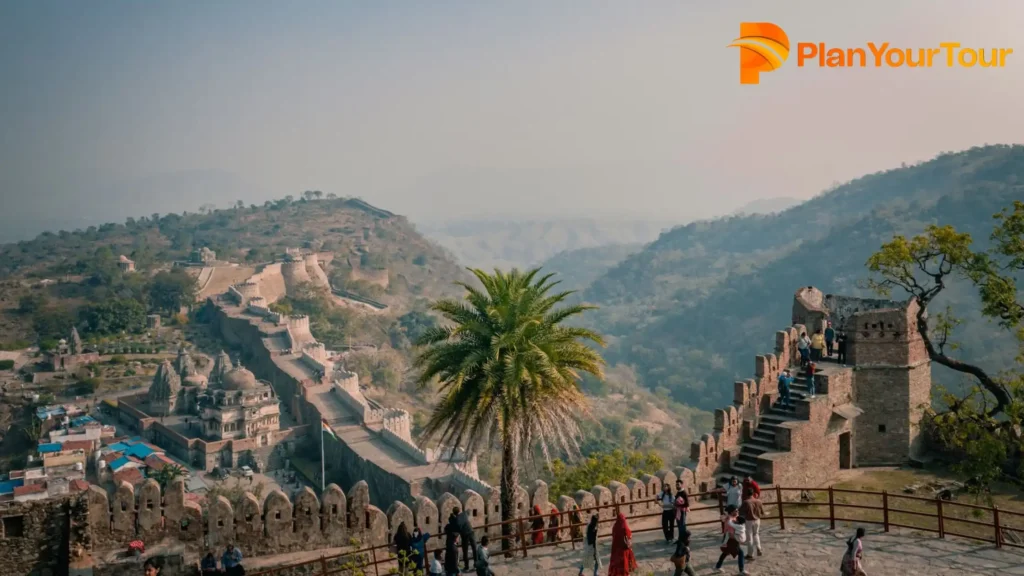
Kumbhalgarh Fort is one of the five hill forts in Rajasthan which was declared a UNESCO World Heritage Site in 2013. Located in the Rajsamand district of Rajasthan, about 82 km from Udaipur, Kumbhalgarh is the second largest wall (38 km) after the Great Wall of the fort. China. Built at the foothills of the Aravalli ranges, it is surrounded by thirteen mountain peaks of the ranges and is situated at an altitude of 1,914 meters. The magnificent fort is situated in the middle of a forest which has been converted into a wildlife sanctuary. It is the second-largest and most important Mewar fort in Rajasthan after Chittorgarh palace.
During the reign of the Mewar kings in Rajasthan, the royal fort was built by Rana Kumbha in the 15th century between 173 and 1856 AD under the direction of Mandan, who was a very famous architect of the time. The fort was constructed at the same place where an old palace was present which was credited to the Samprati who were the Jain princes of the second century BCE. Named after King Kumbhal, the Kumbhalgarh Fort was cleverly designed on a hilltop to provide a strategic position to protect Mewar kings from enemy attacks.
This fort is also the birthplace of Maharana Pratap, one of the most powerful kings of Mewar. Also, Badal Mahal was constructed inside the fort by Rana Fateh Singh, who was one of the most famous builders of the time. The Badal Mahal, Kumbh Palace, Jain Temple, Bawdi, Chhatris, Reservoir and Brahmani are some of the prominent buildings inside the magnificent fort.3
3. Chittorgarh Fort, Chittorgarh

Built-in the 7th century AD by local Maurya rulers (often confused with royal Mauryan rulers), Chittorgarh Fort in Rajasthan is one of the largest forts in India. The Chittorgarh Fort, clearly known as Chittor, is grandly spread over a hill of 590 feet in height and spread over 692 acres of land, which is a fine example of popular Rajput architecture. The grand structure of the fort has several entrances built by later rulers of the Maurya dynasty. The Chittorgarh Fort was earlier the capital of Mewar and is now located in the city of Chittorgarh. The Chittorgarh Fort resonates with stories of valour and sacrifice and displays the Rajput culture and values in the true sense. Due to its magnificent building, Chittorgarh Fort has declared a UNESCO World Heritage Site in the year 2013.
There is a 1 km long road leading to Chittorgarh Fort and is quite steep. It is often considered the pride of the state because of the many historical sacrifices associated with it. Chittorgarh Fort is also called Jal Fort because it once had 84 reservoirs, but now only 22 of them are left. The two major attractions of the fort are the tower Vijay Stambh and the Kirti Stambh. The Vijay Stambh refers to the Tower of Victory and the Kirti Stambha means the Tower of Fame. Towers are illuminated in the evening and it looks even more beautiful. The fort complex has several palaces and temples in addition to the towers, the most notable being the Meera temple.
4. Bagore Ki Haveli, Udaipur
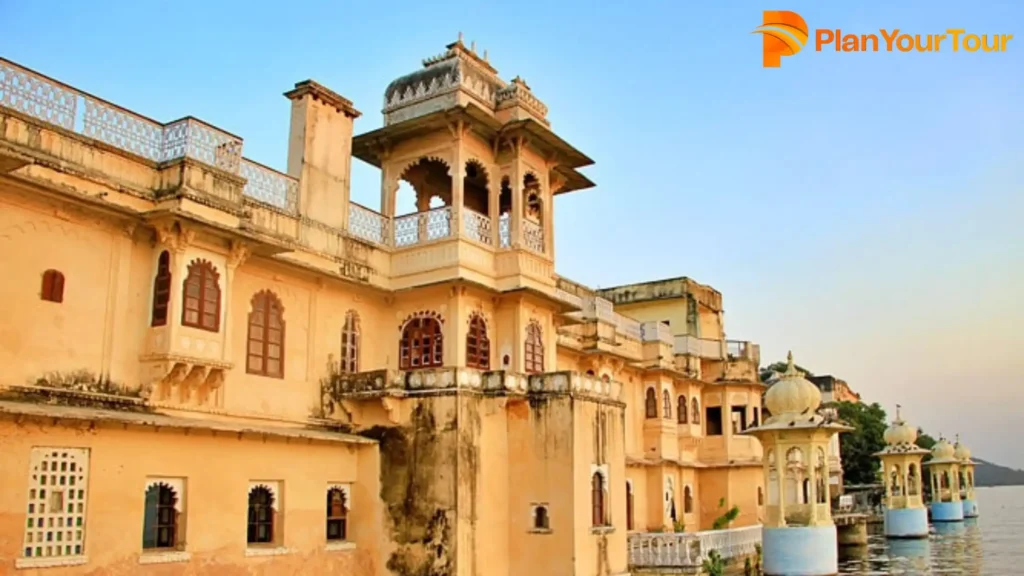
Located on the Gangaur Ghat Marg of Udaipur in the state of Rajasthan, Bagore Ki Haveli is a grand palace built in the eighteenth century on the banks of Lake Pichola. Boasting over a hundred rooms, with elaborate displays in mirrors and glassworks, the mansion was built by the Prime Minister of the Mewar Empire- Amar Chand Barwa. Beautiful paintings and murals from the Mewar era beautify the palace walls; The Queen’s Chamber is the most popular, displaying two very gorgeous peacock glass and mirror sculptures. Repeatedly renovated and renovated, the mansion is eventually transformed into a museum, which is filled with not only regular tourists but also history buffs and culture explorers. The main attraction of the haveli is the popular heritage dance show held here every evening which showcases the culture and folk tradition of Rajasthan.
5. Sajjangarh Palace, Udaipur

Situated atop a hill, on the outskirts of Udaipur city, Sajjangarh Palace is a former royal residence belonging to the Mewar dynasty, which ruled the place for centuries. The palace complex is named after its patron Maharana Sajjan Singh, who ordered its construction and built it in 1884. Originally intended to be a nine-storey astronomical observatory to note and assess the arrival and pattern of monsoon clouds, it is easily viewable from the palace as it is located at a strategic vantage point on a hill in the Aravalli. , Called Bansadara peak. For this reason, it is also called the Monsoon Palace. This will also create employment opportunities for subjects.
However, due to the premature death of Maharana Sajjan Singh, this did not change in reality. His successor Maharana Fateh Singh converted it into a place of entertainment. During and after his tenure, the Monsoon Palace was used primarily as a hunting lodge for the royal family of Mewar and their guests. In line with contemporary styles of the time, the Sajjangarh Palace displays an attractive Rajput architecture, complete with towering towers, bastions, balconies and pillars. It even had the facility of rainwater harvesting in unique scientific techniques.
6. Jag Mandir Palace, Udaipur
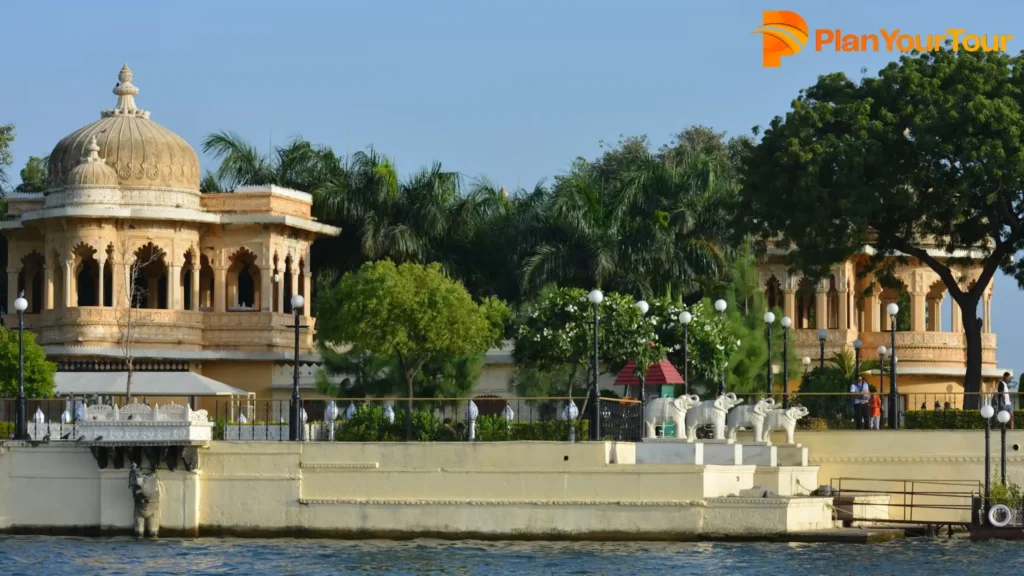
Jag Mandir Palace (or ‘The Lake Garden Palace’) is a magnificent palace situated on the southern island of Pichola Lake in Udaipur, Rajasthan. The palace is three-storeyed and the structure is made of marble and yellow sandstone. It would be a pleasure to see the eight life-size elephants carved in pure white marble guarding the palace. It was completed by Maharana Jagat Singh in the early years of the 17th century. Construction was started by Maharana Amar Singh in 1551 and continued by Maharana Karan Singh where it was served as a hiding place for Shah Jahan and was finally completed by Maharana Jagat Singh I.
On a visit to this palace, some of the most famous places to visit are Gul Mahal, where Shah Jahan lived with his family. The place is built in the style of Islamic architecture. A mosque was built here to cater to the religious needs of Shah Jahan. The Bada Pathans’ palace (made of 12 slabs of marble), the Kunwar Lada’s palace (palace for the prince), and the Zenana palace (chamber for royal women) are other must-visit pavilions. The Jag Mandir Palace also has orchards decorated with roses, jasmine flowers, palm trees, frangipani trees and bougainvillaea. The palace currently includes a restaurant called ‘Darikhana’, which serves Rajasthani food. You can also see the museum where the history of that place has been preserved.
7. Bada Mahal, Udaipur

Dating back to the 17th century, the large palace is an incredible structural marvel. Built-in the Rajput-Mughal architectural style, the palace is considered to be the male section of the City Palace. Every city of Rajasthan is known for the grandeur of its monuments. Nowhere else in India will you find fortresses, palaces and palaces so grand and exquisite, so much that it is a wonder to people all over the world. The culmination and celebration of structural grandeur and architectural marvel, Bada Mahal is yet another historical site that adorns the city of lakes in Rajasthan.
If you translate the name into English, it means ‘Big Palace’. It is also known as the Garden Palace due to the well-maintained, well-maintained gardens around the building. Dating back to the 17th century, the Bada Mahal was believed to have a men’s section of the city’s palace, where they engaged in casual conversation and fun. The palace stands atop a 90-foot-high natural hill overlooking the city of Udaipur. The huge pillars, elaborate courtyards and royal balconies all reflect contemporary architectural styles of that era – a combination of Rajput and Mughal influences. Painted mirrors and intricate carvings on the walls beautify the interiors of the Bada Mahal, while outside are lush green lawns, beautiful fountains and a beautiful garden. Bada Mahal will be an interesting addition to your sightseeing list in Udaipur, and will also serve as a great location for your social media snaps.
8. Fateh Prakash Palace
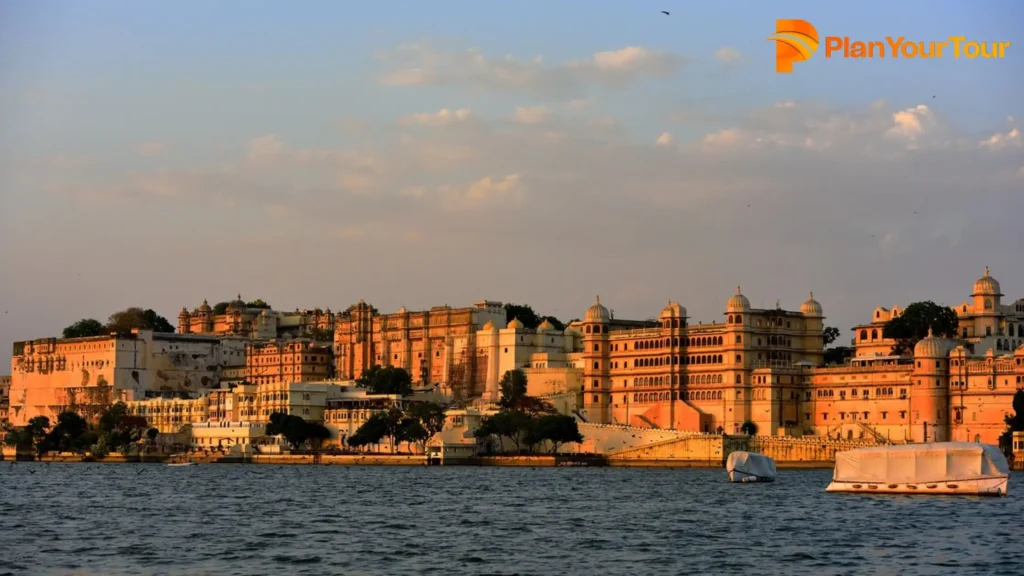
This palace of Chittorgarh takes Rajput grandeur to a new level. The architecture is superb, and the layout is superb. There are many corridors and there is a rich display of Rajasthani paintings, the presence of a large variety of crystal artefacts also shows love for the king. Now, a large part of the fort has been converted into a museum and royal crystal items take up a large part of the display.

